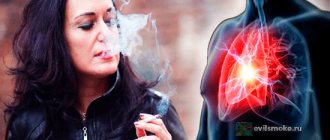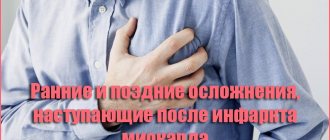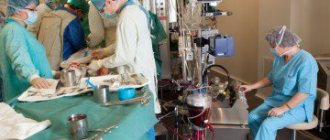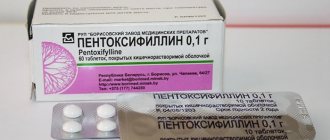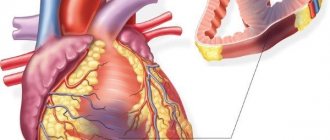- Causes and signs of shortness of breath
- Possible consequences
- What to do if shortness of breath occurs after a heart attack?
- Folk remedies and advice
- Prevention
Myocardial infarction is a very scary and dangerous disease that develops due to partial death of the heart muscle due to impaired blood flow to it. One of the first consequences of the disease is shortness of breath. It is expressed in attacks of suffocation and a feeling of lack of air, that is, it is difficult for a person to take a breath and fill the lungs with air.
Causes and signs of shortness of breath
First of all, this phenomenon occurs due to a malfunction in the functioning of the left ventricle due to the lack of blood flow into the aorta and its stagnation in the small circle of the circulatory system. Then the blood vessels become overfilled, and gas exchange in the lungs is disrupted, which causes shortness of breath. Due to disturbances in the blood flow, tissues and systems of the body, oxygen starvation occurs, which can lead to irreversible processes and serious complications.
A heart attack is characterized by the death of part of the heart muscle, and in order for the patient’s body to continue to be supplied with oxygen, the person has to breathe frequently.
As a result of a heart attack, the left ventricle of the heart experiences tension in its functioning, which contributes to the occurrence of attacks of suffocation and sensations of difficulty in breathing. This phenomenon in medical terminology is called dyspnea.
Shortness of breath may not occur immediately, but may make itself felt after some time. At the initial stage, it may appear during physical activity, but with the further development of the disease, attacks of suffocation can begin in a person even in a calm environment. They can overtake the patient in a lying position, which forces him to take an upright position. This phenomenon is called orthopnea and can occur even at night.
Shortness of breath can be recognized by the following signs :
- acute feeling of lack of air;
- you need to make an effort to inhale;
- it is difficult to take a deep breath;
- feeling of tightness in the chest;
- rapid breathing accompanied by excursion of the sternum;
- breathing occurs accompanied by extraneous sounds: whistling, wheezing, bubbling.
If you notice any of the above symptoms, consult your doctor immediately. After all, only if you seek medical help in a timely manner can you quickly and effectively get rid of such post-infarction consequences.
Complications
Life after a heart attack does not end, because it is not a death sentence. Many patients mistakenly believe that a heart attack deprives them of many things, but this attitude is incorrect.
Some part of the heart has died, but the rest of the myocardium is alive, so it is necessary to help the affected organ adapt and compensate for the missing tissue. A patient after a heart attack can independently help his body return to its former life.
note
It is necessary to carefully read the medical recommendations and ask the treating cardiologist to explain your situation and the degree of myocardial damage.
Many patients are in a rather serious condition upon discharge, but still most heart attack patients feel quite tolerable, because what hurt before has already died off, so nothing else hurts. But patients after a heart attack, fearing a repeat attack, begin to deny themselves everything, which is not entirely true. It is enough to simply avoid provoking factors so that a heart attack never bothers you again.
Heart attack outcomes are quite varied. The most unfavorable of them is death, which usually occurs with extensive large-focal heart attacks. In general, the consequences of myocardial infarction are divided into acute and long-term.
The former develop against the background of necrosis and are caused by acute failure of the left ventricular circulation, arrhythmic disorders, and thrombus formation.
Long-term consequences are associated with chronic myocardial failure, provoked by scarring of dead tissue.
Acute consequences
Each case of a heart attack has its own set of complications. The consequences of the acute period are sometimes very difficult to prevent.
The most common acute outcomes are:
- left ventricular arrhythmia;
- left ventricular fibrillation;
- arrhythmic disorders;
- cardiac left ventricular failure;
- cardiogenic shock;
- mitral insufficiency;
- rupture of the septum between the ventricles or the ventricular wall;
- pericarditis;
- thromboembolism;
- pulmonary edema, which is often accompanied by suffocation and shortness of breath;
- left ventricular aneurysm.
Treatment of arrhythmic disorders that arise against the background of a heart attack should be carried out as soon as possible from the moment of their occurrence. Ischemic myocardial damage leads to a decrease in the overall contractile force of the heart. This leads to blood stasis in the pulmonary circle and insufficient blood supply to the peripheral organs. As a result, pulmonary edema develops during a heart attack.
Pulmonary edema develops mainly after a transmural infarction, although it also occurs with minor damage to the heart muscle. Pulmonary edema is often characterized by symptoms such as increasing shortness of breath, turning into a cough, which is initially dry and then accompanied by the release of white, transparent, foamy sputum.
If you do not pay attention to the symptoms that appear after a heart attack for a long time, severe pathologies may develop:
- Pulmonary edema;
- Cardiogenic shock;
- Acute heart failure;
- Cardiosclerosis.
Cardiosclerosis is called tissue scarring. Instead of dead fibers, the connective tissue “takes over” their functions, resulting in the formation of a scar on the organ. This development of the disease leads to deformation of the valves, the ventricles begin to enlarge. As a result, the patency of blood vessels in the heart becomes clogged.
The pathology can be identified by swelling of the extremities and acute lack of air. During the examination, the liver is determined to be enlarged, and the heart muscle contracts quite often. The patient notes increased blood pressure and notices swelling of the veins in the neck. At the initial stage, dyspnea develops into apnea. A person suffers from constant fatigue and decreased performance. Tachycardia is diagnosed in men.
After stopping an acute attack, the patient’s health does not always improve. In some cases, complications may arise that manifest themselves suddenly or increase over time. Very often they pose a threat to the patient's life. Shortness of breath can be a symptom and a very alarming signal indicating the occurrence of such complications.
The most serious and dangerous are: pulmonary edema, cardiosclerosis, acute cardiovascular failure, cardiogenic shock, thromboembolism, cardiac rupture, aneurysm, arrhythmic disorders and other deadly conditions.
Cardiogenic shock
Possible consequences
If you do not go to the hospital in time, a person who has had a heart attack may develop a number of concomitant heart pathologies and other post-infarction complications, such as:
- cardiosclerosis;
- swelling in the lungs;
- acute failure of the cardiovascular system;
- cardiogenic shock.
Cardiosclerosis is a type of coronary disease characterized by a process in which connective tissue replaces the non-functional part of the heart muscle, resulting in the formation of a scar on the organ. This causes deformation of the valves, enlargement of the ventricles and impaired patency of the heart vessels. This disease can be identified by the following signs:
- acute lack of air;
- swelling of the limbs;
- liver enlargement;
- rapid heartbeat;
- high blood pressure;
- heart rhythm disturbances;
- swelling of the veins in the neck.
At the beginning of the disease, attacks of dyspnea occur, which later develops into apnea. All these phenomena are accompanied by increased fatigue, decreased performance, lack of appetite, and in men - tachycardia.
Pulmonary edema is another complication after a heart attack, which occurs when the left ventricle of the heart fails. This pathology is life-threatening, since if you do not react in time, death is possible. Signs of swelling may include:
- shortness of breath with extraneous sounds (wheezing, wheezing);
- difficult and frequent breathing;
- pale skin, fingers, lips;
- coughing attacks with the appearance of pink foam at the mouth.
With extensive myocardial damage, there is a possibility of developing cardiogenic shock . This disease leads to disturbances in the functioning of the heart and is accompanied by the following symptoms:
- the appearance of shortness of breath;
- decreased blood pressure;
- pain in the sternum;
- covering the skin with pale bluish spots.
Treatment of the disease is aimed at saving the patient's life.
In addition to the above consequences, shortness of breath can lead to disruption of the functioning of many vital human organs, as it indicates the presence of interruptions in the functioning of the heart. As a result, a blood clot can form, which at any moment can separate from the walls and cause obstruction of the vessels of the circulatory system in any part of the body.
Sometimes the appearance of shortness of breath indicates a second heart attack, so it is very important to immediately consult a doctor.
Symptoms of the disease
Symptoms of myocardial infarction occur suddenly, so they can catch a person anywhere and even, which is especially dangerous, on the street. Harbingers of the disease are sharp and severe (“dagger”) pain in the chest area, which radiates to the arm and back. The pain does not stop even after dissolving a nitroglycerin tablet or other similar remedy.
Heart attack
A person experiences strange attacks of fear, increased sweating, dizziness, nausea, abdominal pain, and the skin turns pale. Breathing suddenly becomes worse, and the person may stretch or tear their clothing to make breathing easier. It happens that a person cannot turn his tongue, as a result of which speech becomes confused, incomprehensible and slow. Blood pressure may rise or remain normal. and then drops sharply.
These are the first signs that require a person to urgently call an ambulance. The attack lasts differently, 15-30 minutes or more, it all depends on the specific case. But you need to know that fifteen minutes is enough for necrosis to form on the heart muscle.
Sometimes atypical manifestations of myocardial infarction are observed, in which case abdominal pain, impaired coordination of movements, and severe shortness of breath occur. Sometimes a heart attack occurs without any symptoms of pain at all, but is only characterized by sudden attacks of anxiety and sleep disturbances.
What to do if shortness of breath occurs after a heart attack?
If shortness of breath occurs, you need to calmly analyze what could have triggered it, and immediately tell your doctor about all observations. After the examination, the doctor will prescribe medications and give basic recommendations to improve your well-being.
Among the main recommendations that can alleviate the manifestation of post-infarction phenomena are:
- Take daily walks in the fresh air. You need to avoid crowded and dusty places; it is best to walk in a park or forest for at least 30 minutes every day.
- Do the “Blowing Kisses” exercise.
- Strengthen your immune system to avoid getting the flu or ARVI. This could be hardening, taking vitamin complexes and supplements.
- Raise the head of the bed if shortness of breath bothers the patient when he lies down. You can try placing a couple of pillows under your head to change the angle of your body.
- Eliminate harmful addictions such as alcohol, smoking, etc.
- Learn to take a deep breath, filling not only the chest with air, but also the stomach. You need to inhale through your nose and exhale through your mouth, as this will help eliminate attacks of shortness of breath.
- Carry out physiotherapy and breathing exercises. A set of exercises should be selected for the patient by the doctor individually.
- Use an inhaler. It is recommended to breathe through an inhaler before performing physical therapy.
- Take trips to the pool. Swimming and moist air have a beneficial effect on the respiratory organs.
following medications may be prescribed:
- cardiotonic action (“Korglikon”, “Digoxin”);
- restoring the cardiovascular system (“Ramipril”, “Quinapril”, “Trandolapril”);
- vasodilator action (“Isoket”, “Nitroglycerin”, “Minoxidil”);
- antiarrhythmics, which prevent cardiac disorders, “Carvedilol”, “Celiprolol”);
- anticoagulant action, which thins the blood and prevents the formation of blood clots (Warfarin, Sinkumar, Arixtra, Heparin);
- lowering cholesterol levels in the blood (“Anvistat”, “Lipostat”, “Zokor”);
- diuretic action (Britomar, Veroshpiron, Furosemide, Diacarb).
In addition to the use of medications, the doctor may refer the patient to undergo a course of oxygen therapy . This therapy is used to restore full respiratory functions and helps compensate for the lack of oxygen in the patient’s body. When undergoing this treatment method, shortness of breath may disappear, or its frequency may decrease due to the normalization of heart function. Oxygen therapy also increases the therapeutic effect of medications.
In case of acute respiratory rhythm disturbances, abnormal frequency or absence, ventilation of the lungs to save the patient’s life.
If drug treatment does not help, surgical intervention : elimination of valve defects, implantation of a pacemaker, ventricular or heart transplantation.
Folk remedies and advice
Folk remedies can to some extent alleviate shortness of breath, as they are based on decoctions of medicinal plants that have bronchodilator and expectorant properties similar to synthetic drugs. Also, extracts of medicinal plants are included in many medicines. For these reasons, you can try using folk recipes to alleviate the first manifestations of shortness of breath.
To prepare the medicine yourself, you usually use herbs such as peppermint and yarrow, as well as the roots of lovage, licorice, and cyanosis. Prepare and consume the product like regular tea.
There is a recipe using aloe leaves, which must be picked and infused in vodka for 10 days. It is recommended to use this infusion one teaspoon at a time, adding a tablespoon of honey. All this can be washed down with tea 10 minutes after taking it.
The following traditional medicine recipes are also used:
- Squeeze the juice from 10 lemons, add 10 heads of chopped garlic to them and mix this mixture with 1 liter of honey. Leave the product for a week, after which you should consume 4 teaspoons per day.
- Squeeze the juice from 24 lemons, add 350 grams of chopped garlic to it, leave this mixture for 24 hours and take 1 teaspoon, previously dissolved in half a glass of water.
Reviews from people who have experienced the effects of home remedies are encouraging: some noticed a positive result after the second week of use.
However, we must be aware that folk remedies are designed to remove the symptoms of the disease, and not its causes. Therefore, it is best to seek medical help from your doctor at the first signs of difficulty breathing and carry out treatment with traditional methods only with his consent and in combination with drug therapy.
Prevention
Basic prevention of shortness of breath in the post-infarction period is based on the elimination of factors that can provoke it. Doctors advise leading a healthy lifestyle, giving up bad habits, taking daily walks in the fresh air, and maintaining a daily routine that includes sleep for at least 8 hours. The patient may also be referred for preventive treatment to a cardiological sanatorium.
Excess weight can contribute to the appearance of shortness of breath, so it is necessary to develop measures to reduce it, based on a proper low-calorie diet. You should exclude salt, fried meat and fish, radishes, beans, radishes, milk, cabbage, peas, onions, garlic from your diet, and also minimize the consumption of coffee, cocoa, alcohol, and strong tea. You should not include in your diet foods that contain high levels of cholesterol, such as egg yolks, liver, brains and internal organs of animals.
With the permission of the doctor, you can perform physical therapy and go for a massage. The patient should not worry under any circumstances, so it is necessary to limit him from all stressful situations. You also need to place calming tablets or drops in a visible and accessible place. Raise the head of the bed 35-40 degrees so that the person is in a semi-sitting position. It is necessary to monitor blood pressure daily, as well as visit a cardiologist in a timely manner and have a cardiogram done.
Patients who have had a heart attack need constant monitoring and control by a doctor, as there is a high likelihood of complications developing. The patient himself must be attentive to his health: follow all recommendations, take medications on time and report symptoms associated with impaired breathing or heart rhythm.
Types of disease
Myocardial infarction, depending on the size of the affected area, is divided into small-focal and large-focal. They also highlight:
- complicated and uncomplicated;
- typical and atypical;
- primary, secondary and recurrent.
The heart attack itself proceeds in accordance with the following stages:
- Pre-infarction period;
- The most acute period (ischemia stage);
- Acute (necrosis stage);
- Subacute (organization stage);
- Post-infarction period (stage of scar formation).

